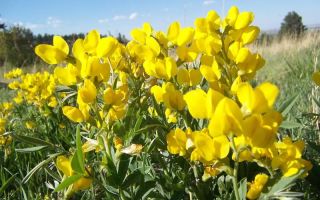Content
- 1 What it looks like and where it grows
- 2 The chemical composition of thermopsis herb
- 3 What helps and how is thermopsis useful?
- 4 Preparation and application methods
- 5 Contraindications to the use of thermopsis
- 6 The main side effects of the thermopsis herb infusion
- 7 Collection and procurement
- 8 Conclusion
For respiratory infections accompanied by a cough, it is recommended to take herbal remedies. Thermopsis allows to soften the spasm and remove phlegm. Perennial has pronounced healing properties. Infusion of thermopsis herb is analogous to many medicines for coughs.
What it looks like and where it grows
Thermopsis represents the Legume family. The plant is also called:
- drunken weed;
- mousewort.
Perennial prefers moist meadows:
- East Asia;
- North America;
- Japan;
- China.
The herb includes about 30 varieties. Sometimes the plant is sown as a weed. Thermopsis has branching cord-like roots that can grow up to 3 m in length. Erect stems up to 1 m in height are covered with soft sparse hairs.
The flowering period of thermopsis is observed in April-May. The flowers are of the butterfly type. They are collected in small whorls that cover the raceme located on the stem.
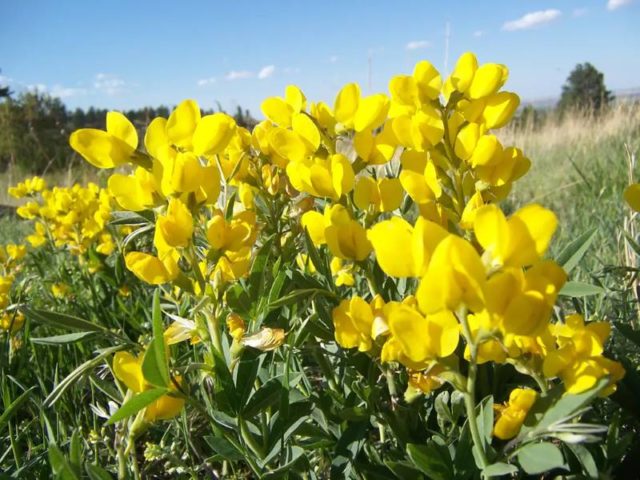
The elliptical fruit ripens by September. They resemble black beans with a greenish tint. The fruits are small in size.
The chemical composition of thermopsis herb
Medicinal plant raw materials include:
- resinous and tannins;
- alkaloids, among which are called cytisine, anagirin, thermospin;
- mucus;
- essential oils;
- ascorbic acid;
- glycosides;
- saponins.
Thermopsis seeds contain the alkaloid cytisine. The presence of these substances in the composition of raw materials makes it poisonous. It is necessary to use the herb of the musculature only as directed by the doctor.
The mechanism of action of thermopsis
The effectiveness of the use of funds made on the basis of drunken grass is due to the presence of saponins, as well as plant alkaloids. The use of drugs based on thermopsis promotes reflex excitation of some parts of the nervous system. They are responsible for the functioning of the respiratory muscles. A sharp exhalation is caused by a combination of the following mechanisms:
- irritation of the corresponding respiratory nerves and the source of adrenaline, which is represented by the adrenal glands;
- stimulation of the gag reflex;
- pressure increase.
The medicinal effect is important not only for a wet cough, but also for the following life-threatening conditions:
- respiratory arrest due to infectious diseases;
- asphyxia;
- shock.
What helps and how is thermopsis useful?
Potions made from a medicinal plant have the following effects:
- anesthetic;
- enveloping;
- antihelminthic;
- anti-inflammatory;
- insecticidal;
- antioxidant.
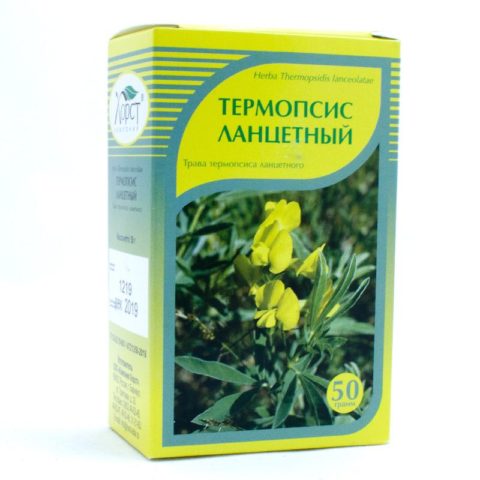
Does thermopsis help children with cough
Drugs made on the basis of drunken herb are not recommended for children under the age of 12 years.However, some medications are designed for use as young as two years of age. Dosage forms promote sputum discharge and can be prescribed exclusively by a pediatrician. This will avoid overdose and side effects.
Preparation and application methods
Thermopsis is used in official medicine. On the basis of raw materials, preparations are made to stimulate the work of the respiratory tract. The most effective dosage forms include:
- syrups;
- tablets;
- alcohol tinctures;
- dry medicines.
Depending on the indications for use, liquid products can be:
- two-component;
- multicomponent.
The appointment of a tincture of thermopsis herb is recommended for severe coughing. The healing effect is due to the presence of alkaloids and saponins in the composition. The tincture increases the activity of the secretion of the bronchial glands. The drug helps to remove phlegm.
When making medicinal infusions at home, thermopsis is combined with butter, milk and soda. Since the muster is a poisonous plant, the recommended proportions and dosages of the funds should be observed.
Thermopsis herb infusion recipe
Aqueous solutions are used in the treatment of:
- severe headaches caused by vasospasm;
- SARS, including influenza, bronchitis and pneumonia;
- intestinal atony;
- reduced pressure;
- lack of appetite;
- depressive disorders and increased anxiety.
The infusion is distinguished by its expectorant properties. Against the background of the use of the thermopsis herb, according to the instructions for use, an increase in mucus secretion in the respiratory tract is observed, which contributes to an increase in the own contractile activity of the bronchi. The removal of phlegm occurs by stimulating smooth muscles.
The infusion includes the following components:
- dried grass - 1 g;
- boiling water - 200 g.
The drug is prepared as follows:
- Raw materials are poured with boiling water.
- The tool is insisted for an hour, and then filtered.
According to the instructions for use, adults take an aqueous solution of thermopsis, 1 tbsp. l. The drug is taken four times a day.
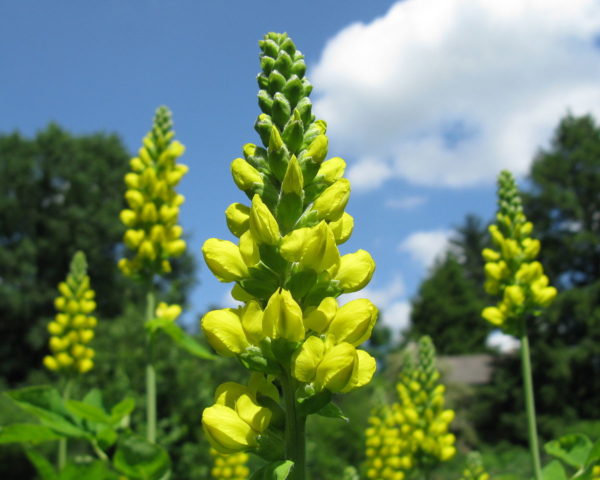
Extract
The formulation is a mixture of standardized herb dry powder and milk sugar. Each gram of the product contains 1% alkaloids. The extract resembles a powder with a brownish tint. It dissolves easily in water. The dosage form is prescribed for adults. The dosage depends on the severity of the disease.
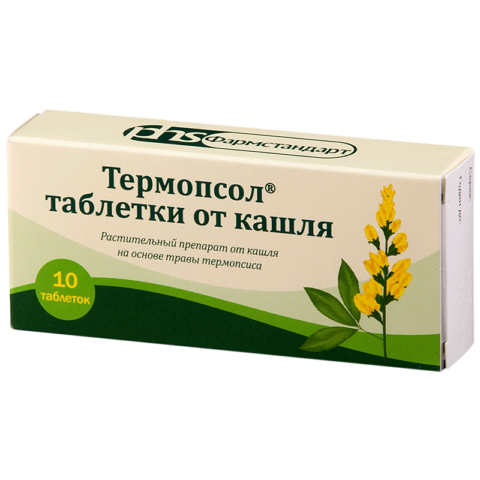
Decoction
The dosage form is prescribed for coughs and other diseases of the bronchi and lungs. Drunk herb decoctions are popular in traditional medicine in Tibet. The aqueous solution is indicated for both adults and children.
For the broth you need to take:
- 2 g of dry raw materials;
- 400 ml of water.
The preparation of the product is simple:
- The herb is placed in a saucepan and boiled over.
- The composition is cooked over low heat for two minutes.
- The drug is insisted for eight or more hours.
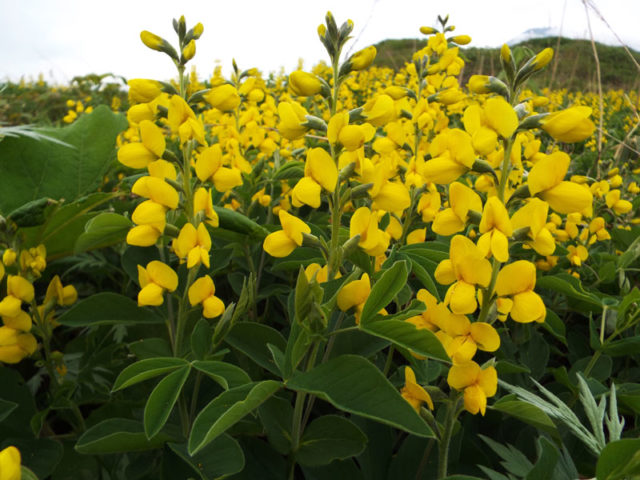
Contraindications to the use of thermopsis
The raw materials are known for their toxicity. Preparations and drugs made from thermopsis are not prescribed in the following cases:
- pregnancy due to the threat of miscarriage due to uterine contractions;
- lactation;
- children under 12 years old;
- hypersensitivity reactions;
- exacerbation of stomach ulcers;
- recovery period after traumatic brain injury;
- chronic pathologies of the kidneys, liver and nervous system.
The main side effects of the thermopsis herb infusion
Adverse reactions are often observed with overdose. Side effects include the following:
- loss of fluid due to profuse vomiting;
- stomach ache;
- itchy skin;
- laryngeal edema.
Collection and procurement
Medicinal thermopsis is actively used in both traditional and folk medicine. Medicines can be purchased at the pharmacy. They have various therapeutic forms. Homemade products are highly effective.
To preserve the medicinal properties of the thermopsis herb, you need to take into account the rules for collecting raw materials. The aboveground parts of the plant are harvested at the time of bud emergence. The periods of the end of flowering and the beginning of fruit ripening are considered favorable for harvesting.
It is recommended to carry out the collection with gloves. This is due to the fact that thermopsis is a poisonous plant. After completing the procedure for preparing raw materials, you need to wash your hands with soap. To protect the respiratory system from grass dust, a gauze bandage should be worn during the drying process.
Collecting grass in one area is carried out once within two years. The aerial parts of the thermopsis are cut off with garden shears, retreating 50 mm from the ground. This will keep the kidney from recovering.
The herb should be spread out on paper or cloth and dried in the sun. When breaking, the raw material should not release juice. Then the grass is chopped up with scissors. Fragments, the length of which is about 5 cm, are laid out for the purpose of drying.
Conclusion
Infusion of thermopsis herb allows you to eliminate cough in children and adults. The dosage form promotes effective sputum discharge. The pharmacotherapeutic effect of the herb thermopsis lanceolate is due to a combination of several mechanisms. When using funds from the muster, it should be borne in mind that they cause a decrease in pressure. The herb is not recommended to be included in the composition of drug therapy during pregnancy, breastfeeding.

